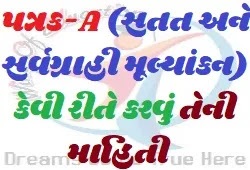Rachanatmak Mulyanan Patrak-A Vishe Ma Mulyankan Ni Mahiti
Subject: - Matter of continuous and comprehensive evaluation
Here are some clarifications regarding the frequently asked questions in the training regarding continuous and holistic assessment.
Question: How to use the new study findings given by GCERT?
Answer: Along with the new textbook, their study findings have also been posted by GCERT on their website www.gcert.gujarat.gov.in. Remember that these study findings are ideally tailored to the given topic. These study findings list the main findings and their sub-study findings as required. At the same time, activities for teaching and learning of various study outcomes have also been given. These activities have to be done whenever we provide the student with a teaching-learning experience.
Question: How and when to select study findings for Patrak-A?
Answer: Patrak-A which we know as constructive evaluation. This is incorporated into the structure of the informal assessment form. Study findings that can be informally verified during the study-teaching process can be selected for constructive evaluation. The selection and evaluation of these study outcomes is a task that requires the teacher's specialized skills. The learning outcomes for this should be decided by the teacher at the beginning of the session so that the assessment of the study outcomes can be planned in advance during the teaching work and continuous evaluation can take place.
Question: If more than 50 study findings are given in the list of study findings given by GCERT then why take study findings?
Answer: The list of study findings given by GCERT is for teaching-learning. When we talk about getting a maximum of 20 study findings, keep in mind that we are talking about Informal Assessment Patrak-A. Patrak-A only has to take a maximum of 30 representative capacity that can be informally assessed.
Question: Based on the study findings given in the unit test, can the assessment be noted in the constructive assessment Patrak-A?
Answer: A unit test is conducted in a fixed structure. And it is a written test, that is, a formal test, when it comes to informal assessment in a creative form. The unit test is taken at the end of the unit or units while constructive assessment Form-A is part of the ongoing assessment that takes place during the teaching-learning process.
Question: If verbal questions have been asked for Constructive Assessment Patrak-A, how to base it? Or how to base the assessment of Patrak-A?
Answer: Earlier we talked in response to a question. Constructive evaluation selects study findings that are evaluated informally. We also know that the teacher has to plan ahead for this type of assessment. Now let's talk about the basics. You must have planned the evaluation method in advance for the study conclusion Patrak-A. This planning can also be your support. You may have noticed it in the evaluation note in the daily book as well. The work done by the student can be used as a basis if you have decided on an informal action test for constructive assessment. Oral quizzes or sometimes collective informal assessments may run if there is no support but the assessment needs to be done consistently.
For example, an oral quiz has been conducted by the teacher for the conclusion of a study and on the basis of this, the achievement has been noted in the constructive Patrak-A. Now again, when an informal assessment is made, it is essential that the rest of the students, with the exception of a few students, can answer.
Download Rachanatmak Mulyanan (Patrak-A) Vishe Mahiti Click Here.











